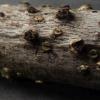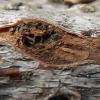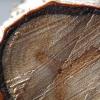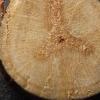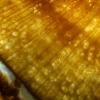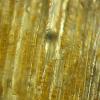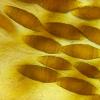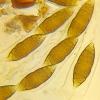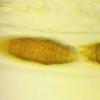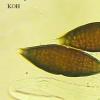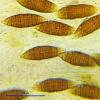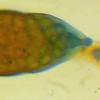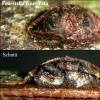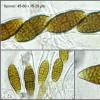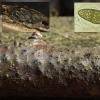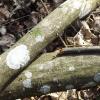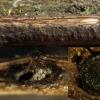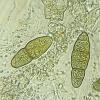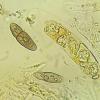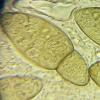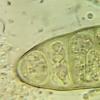
20-12-2025 23:08
Patrice TANCHAUDBonsoir, récolte sur sol sablonneux dans l'arri�

21-12-2025 09:32
Hello.A tiny ascomycete found embedded in wood in

20-12-2025 15:47
Mirek GrycHi.These grew on pine wood that was heavily covere

18-12-2025 21:17
Pol DebaenstThe identification took me to Byssonectria deformi

15-12-2025 07:09
 Danny Newman
Danny Newman
indet. Rutstroemiaceae sp. on unk. fallen leavesMc

19-12-2025 10:10
Patrice TANCHAUDBonjour, récolte réalisée en milieu dunaire, a

18-12-2025 17:23
 Bruno Coué
Bruno Coué
Bonjour,je serais heureux d'avoir votre avis sur c
With big spores? [Fenestella fenestrata]
Mirek Gryc,
07-04-2021 11:03
Hello everyone.
Substrate can not be able to determine so I place photos.
Is anyone able to help me specify the genre?
Spores: Me = 58.1 × 17.3 um
Regards
Mirek
Norbert Heine,
07-04-2021 12:01
Mirek Gryc,
07-04-2021 12:25
Re : With big spores?
Hi Norbert
Both macroscopic and spores are very similar so I think you're right about the genre.
I did not know this species so far, I read a little about him in the literature to get more data, although it will only be pure formality because your type is very likely :)
thank you very much
Mirek
Both macroscopic and spores are very similar so I think you're right about the genre.
I did not know this species so far, I read a little about him in the literature to get more data, although it will only be pure formality because your type is very likely :)
thank you very much
Mirek
Viktorie Halasu,
07-04-2021 14:27

Re : With big spores?
Hi Mirek,
I'm not sure if the silver epidermis is ok for it, but Alnus has such a triangular pith.
Viktorie
I'm not sure if the silver epidermis is ok for it, but Alnus has such a triangular pith.
Viktorie
Alain GARDIENNET,
07-04-2021 16:01
Re : With big spores?
The answer is probably here : https://www.ingentaconnect.com/content/nhn/pimj/2020/00000044/00000001/art00001
Norbert Heine,
07-04-2021 17:37

Re : With big spores?
Thank you, Alain, for the link to this fantastic publication! I didn't know it until now. And I see there is one species named after you as its collector - very nice!
Norbert
Hermann Voglmayr,
08-04-2021 10:55
Re : With big spores?
Yes, also the bark looks like Alnus. Which is the type host of Fenestella fenestrata sensu stricto, for which the spores (large size, dark colour, subhyaline apiculi, very dense muriform septation) also fit well.
For a detailed description of Fenestella fenestrata sensu stricto, see https://www.sciencedirect.com/science/article/pii/S0166061617300489
Hermann
Alain GARDIENNET,
08-04-2021 11:48
Re : With big spores?
Hi,
And perhaps could Norbert check the one on Quercus to compare to F. parafenestrata ?
Hermann, when we meet a such fungus on Quercus, is it possible to distinguish F. fenestrata end F. parafenestrata basing to morphology ?
All the best,
Alain
Hermann Voglmayr,
08-04-2021 12:14
Re : With big spores?
Hi Alain,
ya, that's difficult... Spores of F. fenestrata are in mean larger than those of F. parafenestrata, and appear to be more densely septate (i.e. the cells appear smaller). But one also has to say that these species are rarely found (and probably uncommon), and therefore we didn't have enough collections at hand to fully evaluate the intra- and interspecific variability within these two species.
As with many species, reliable species identification may only be possible with sequence data in intermediate collections not fully showing these differences. And, there may be additional undescribed species around....
Best,
Hermann
Mirek Gryc,
08-04-2021 13:29
Re : With big spores? [Fenestella fenestrata]
Hello everyone again and thank you for very valuable comments.
Yesterday evening I read the article indicated by Alain and I came to the conclusion that this must actually be F. Fenestrata.
However, she wondered the small width of spores in my collection Although the author of the quoted publication mentioned that the collections were studied strongly mature.
The comments contained in the article indicated by Hermann, explain my fears. It follows that the width of spores varies significantly depending on the tested collection. In that case, the width of my spores is within the right range.
Once again, thank you very much and greetings to all.
Mirek
Yesterday evening I read the article indicated by Alain and I came to the conclusion that this must actually be F. Fenestrata.
However, she wondered the small width of spores in my collection Although the author of the quoted publication mentioned that the collections were studied strongly mature.
The comments contained in the article indicated by Hermann, explain my fears. It follows that the width of spores varies significantly depending on the tested collection. In that case, the width of my spores is within the right range.
Once again, thank you very much and greetings to all.
Mirek
Mirek Gryc,
02-03-2022 14:34
Re : With big spores? [Fenestella fenestrata]
Welcome back.
I'm coming back to the topic because a few days ago I found a very similar fungus but on another substrate and with a bit other spores. I do not assume a new thread because the collection is very weak, so I did not even do good photos. They grew on the Carpinus betulus. Spores of the size match Fenestella parafenestrata but I have not heard about this genre on Caprinus. Similar, but slightly smaller spores have F. media that occurs on such a substrate.
Apicule on spores occur rare.
Spores:
(46.7) 46.74 - 50.7 × (15.8) 15.85 - 18.7 µm.
Maybe someone with a greater experience will share an opinion with me?
greetings
Mirek
I'm coming back to the topic because a few days ago I found a very similar fungus but on another substrate and with a bit other spores. I do not assume a new thread because the collection is very weak, so I did not even do good photos. They grew on the Carpinus betulus. Spores of the size match Fenestella parafenestrata but I have not heard about this genre on Caprinus. Similar, but slightly smaller spores have F. media that occurs on such a substrate.
Apicule on spores occur rare.
Spores:
(46.7) 46.74 - 50.7 × (15.8) 15.85 - 18.7 µm.
Maybe someone with a greater experience will share an opinion with me?
greetings
Mirek
Hermann Voglmayr,
02-03-2022 14:52
Re : With big spores? [Fenestella fenestrata]
Dear Mirek,
This is Pleomassaria carpini.
Best, Hermann
Mirek Gryc,
02-03-2022 15:31
Re : With big spores? [Fenestella fenestrata]
Hi Hermann.
It's again an unknown species.
A horrible lot of very similar species.
Thank you for identification!
greetings
Mirek
It's again an unknown species.
A horrible lot of very similar species.
Thank you for identification!
greetings
Mirek

